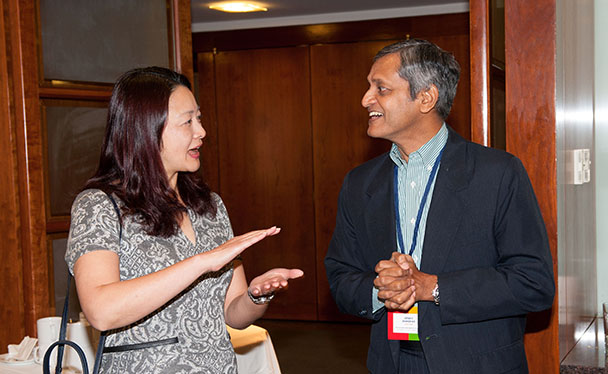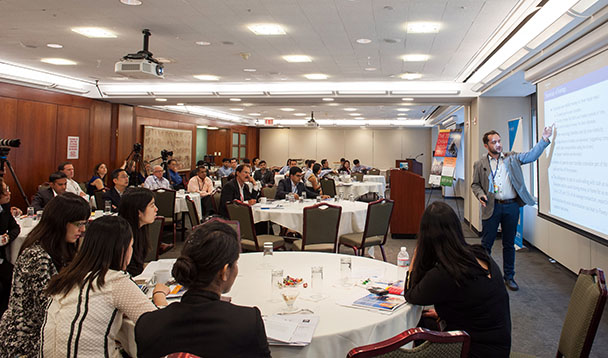A CKGSB Knowledge Series panel discussion highlighted the implications for companies, customers and economies of the e-commerce surge in China and India and the nations’ potential as an e-commerce marketplace for Western firms.
The September 17 CKGSB/Yale panel discussion, New E-Commerce Trends in China and India, was organized by CKGSB’s New York office. Offered as a co-production of the Customer Information Management Center of CKGSB and the China India Insights Program of the Center for Customer Insights at the Yale School of Management, it set the stage for the seventh annual China India Insights Conference on September 18-19.
The panelists’ diverse expertise was in keeping with the conference’s mission: to provide a forum for scholars from across disciplines to share the best available research on consumer and corporate behavior in China and India, two of the world’s fastest growing markets.
The moderator for the two-hour event at CKGSB’s New York office was K. Sudhir, the James L. Frank Professor of Marketing, Private Enterprise and Management at Yale School of Management and Director of the Yale China India Insights Program.

The speakers at “New E-Commerce Trends in China and India”
panel discussion pose for a photograph
The panelists were Chen Zhiwu, Professor of Finance at Yale School of Management; Arun Sundararajan, Professor of Information, Operations and Management Sciences and the Robert L. and Dale Atkins Rosen Faculty Fellow at New York University Stern School of Business; Naufel Vilcassim, Professor of Marketing and Chair of Marketing Faculty at London Business School; and Doreen Wang, Global Head of BrandZ, Millward Brown.
The discussion illuminated both the opportunity and the challenge e-commerce companies in the West and elsewhere face in reaching out to consumers in emerging markets. For instance, although the Internet would allow firms to connect with consumers in China without needing to spend to establish bricks-and-mortar stores, the companies would confront Chinese shoppers’ preference for paying for purchases via Alibaba’s Alipay or Tencent Holdings’ WeChat messaging app mobile payment system. Moreover, Chinese firms dominate e-commerce in the country, particularly among peer-to-peer business platforms such as applications for ordering taxis.
Focus on trends
In her opening remarks, Sun Baohong, the Dean’s Distinguished Chair Professor of Marketing and the Associate Dean of Global Programs and Director of the Customer Information Management Center at CKGSB, drew attention to the impact of E-commerce on globalization and innovation – two trends upon which CKGSB has focused intensely in its effort to educate the world’s business leaders. A focus on humanity rounds out the trio of themes in educating executives at the business school.
Illustrating China’s advances in e-commerce, Professor Sun said: “Today, if you don’t use mobile transactions, or mobile payments, you are off as a consumer. You are not even welcomed by even a taxi driver.” Fifty-one percent of consumers in China buy online compared with 28 percent in the United States, she said.
Professor Sun also cited statistics illustrating CKGSB’s core value among global business schools. Just 13 years after its launch, it now annually educates about 600 Executive MBA students, 200 part-time MBAs and 50 full-time MBAs, she said. About 2,000 people a year receive training through the school, whose 8,000 alumni represent firms accounting for 15 percent of China’s GDP.

CKGSB Professor of Marketing Sun Baohong (left) in discussion at the
“New E-Commerce Trends in China and India event in New York City
At the outset, Professor Sudhir said the contrasting ways that China and India have emerged in the e-commerce space potentially are a rich source of examples and ideas for management strategies in the sector. China is the world’s largest e-commerce economy – and a leading e-commerce innovator – with sales valued at $430 billion US By comparison, US e-commerce sales are valued at $300 billion. India e-commerce, by contrast, is valued at just $15 billion. But its fivefold growth in the past half-decade and the huge amount of money flowing into the sector have raised expectations that it will grow even more tremendously in the next few years, Prof. Sudhir said.
Professor Chen said the increasing popularity of smartphones and mobile technology helped accelerate e-commerce adoption in the countries. In the late 1990s, e-commerce was sluggish in China, with the Internet mostly used for gaming and for information. When e-commerce began to take off starting in 2007, Internet activity still was mostly desktop and PC-based.
“Since 2012, the mobile Internet has generated a much larger increase of e-commerce,” Professor Chen said.
Mobile also has sped up Internet finance adoption in China – far faster than in the US, where a tradition of local community banks with close customer relationships still persists.
“The lack of such a positive legacy (in China) allowed Internet finance to play a special role, because to begin with, there was not much entrenched interest in financial institutions,” Professor Chen said.
In the last 12 months, investment in Internet finance and e-commerce businesses valued at more than $20 billion – or roughly $1.8 billion monthly – by private equity and venture capital firms has created an e-commerce “bubble” that eventually will burst, Professor Chen said.
“Many of the investors will not get any money back. I am almost certain of that,” he said. “Nevertheless, all this hoarding of capital … will nonetheless lead to a lot of good things for Chinese society.”
Ms. Wang pointed out that e-commerce growth in the Chinese retail industry has been helped by the lack of a strong traditional retailing sector. E-commerce, the fastest growing industry in China, is dominated by just two firms – Alibaba, with more than 50 percent of the market, and JD.com, with just under 20 percent.
In China, the top 10 firms by market share are e-commerce companies. By comparison, the top 10 in the US, besides Amazon and eBay, are Internet arms of traditional retailers, such as Macy’s and Wal-Mart Stores.
“China’s traditional retail has developed way behind the US,” Ms. Wang said. “They still have lots of mom-and-pop shops. Even the retail chain there functions as a real estate management – they outsource mechandising, logistics and marketing functions to the smaller companies.
“In competition against the e-commerce, they did not have the capability and capacity to finish all this end-to-end functionality.”
Mobile-savvy consumers
Pointing to continuing e-commerce growth in both China and India, she said both nations have high percentages of young, mobile-savvy consumers who naturally take to e-commerce.
“They have not formed a habit to shop in the traditional retail environment,” she said. “For them, this buy-anywhere, anytime-you-want (approach) is a very natural way of shopping.
“They can move directly in China from cash and skip credit cards and go directly to pay-by-mobile.”

Professor Vilcassim noted that India’s Internet user base – the third largest globally – and its very low penetration of e-commerce position it to become a rich e-commerce market. The evolution of e-commerce in India so far parallels the trend in the US In an industry dominated by business-to-consumer firms, airline ticketing accounts for 30 percent of the Indian e-commerce market.
“The issue is really the industry has moved from the startup phase and is about to move into the scale-up phase,” Professor Vilcassim said. “The first to scale up is the one that is eventually going to succeed in the market.”
Given fragmentation in the market and many new entrants, those who are second or third into the market should specialize rather than trying to compete with an Amazon.com, he said. But when the late entrant specializes, scaling up becomes harder.
“Customer retention is not very high because customers are not very loyal because they are going to be induced by lots of promotions,” Professor Vilcassim said. And despite 4G technology providing acceptable connectivity, logistics challenges remaining in rural areas could hamper the fulfillment part of the e-commerce.
“What is likely to happen in India is computer PC based e-commerce not going to be the way of the future,” Professor Vilcassim said. “It’s going to be app-based, mobile-based e-commerce. Some e-commerce firms are actually shutting down their websites and moving into an app-based e-commerce,” he said.
Point of entry
Professor Sundararajan said that the growing popularity of e-commerce firms such as Ola Cabs, an Uber-like company, which connect people with products that are not purely digital, help drive broader and faster e-commerce adoption.
“Ola is important not just for transportation but for the general Indian e-commerce sector because it is the entry point for a lot of people – for the experience of getting something commercially through a phone,” he said. “Getting actual service.”
Companies such as this “will be a gateway application for a lot of people that are taking the next step toward actually buying the products,” Professor Sundararajan said.
Raising the outlook for e-commerce in India is the 100 million people in the country with high-speed mobile Internet. “India will have more smartphone users than the US soon,” he said. “I doubt very much whether India will be the second-largest e-commerce market in the world but it could likely be the large economy in which the second highest fraction of retail takes place electronically,” Professor Sundararajan said. “I doubt it will surpass China on that one.”